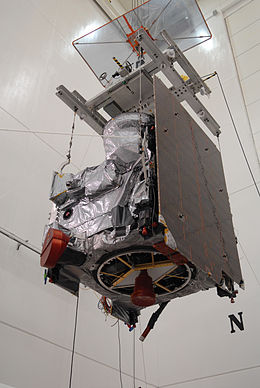GOES 14

GOES 14 during pre-launch processing
|
|
| Mission type | Weather satellite |
|---|---|
| Operator | NOAA / NASA |
| COSPAR ID | 2009-033A |
| SATCAT no. | 35491 |
| Mission duration | 10 years |
| Spacecraft properties | |
| Spacecraft type | GOES-N series |
| Bus | BSS-601 |
| Manufacturer | Boeing, ITT Corporation |
| Launch mass | 3,133 kilograms (6,907 lb) |
| Power | 2.3 kilowatts from solar array |
| Start of mission | |
| Launch date | 27 June 2009, 22:51 UTC |
| Rocket | Delta IV-M+(4,2) |
| Launch site | Cape Canaveral SLC-37B |
| Contractor | United Launch Alliance |
| Orbital parameters | |
| Reference system | Geocentric |
| Regime | Geostationary |
| Longitude | 105° West |
| Eccentricity | 0.0003154 |
| Perigee | 35,773 kilometres (22,228 mi) |
| Apogee | 35,800 kilometres (22,200 mi) |
| Inclination | 0.2184° |
| Period | 1,437 minutes |
GOES 14, known as GOES-O prior to reaching its operational orbit, is an American weather satellite, which is part of the US National Oceanic and Atmospheric Administration (NOAA)'s Geostationary Operational Environmental Satellite (GOES) system. The spacecraft was built by Boeing and is based on the BSS-601 bus. It is the second of three GOES satellites to use the BSS-601 bus, after GOES 13, which was launched in May 2006.
It was launched by United Launch Alliance aboard a Delta IV-M+(4,2) rocket at 22:51 GMT on 27 June 2009, from Space Launch Complex 37B at the Cape Canaveral Air Force Station. Upon reaching geostationary orbit, on 7 July, it was redesignated GOES 14. It underwent a 6-month series of post-launch tests before completing its "check-out" phase and then was placed into "orbital storage mode" or stand-by. Its first full disk image was sent on 27 July 2009
GOES 14 was brought out of storage and began one-minute rapid scans of Tropical Storm Isaac on August 24, 2012. On September 24, 2012, it temporarily assumed the role of GOES-East after GOES 13 experienced technical difficulties. On October 1, 2012 it began moving east at a rate of .9 degrees per day to an ultimate geosynchronous position of 75 degrees west longitude to better cover the Atlantic basin during troubleshooting and repair of GOES 13. GOES 13 was returned to service on 18 October 2012.
GOES 14 was used to monitor Superstorm Sandy in parallel with the repaired GOES 13 and was returned to storage afterwards. GOES 14 was reactivated on May 23, 2013 following another anomaly with GOES 13.
...
Wikipedia
